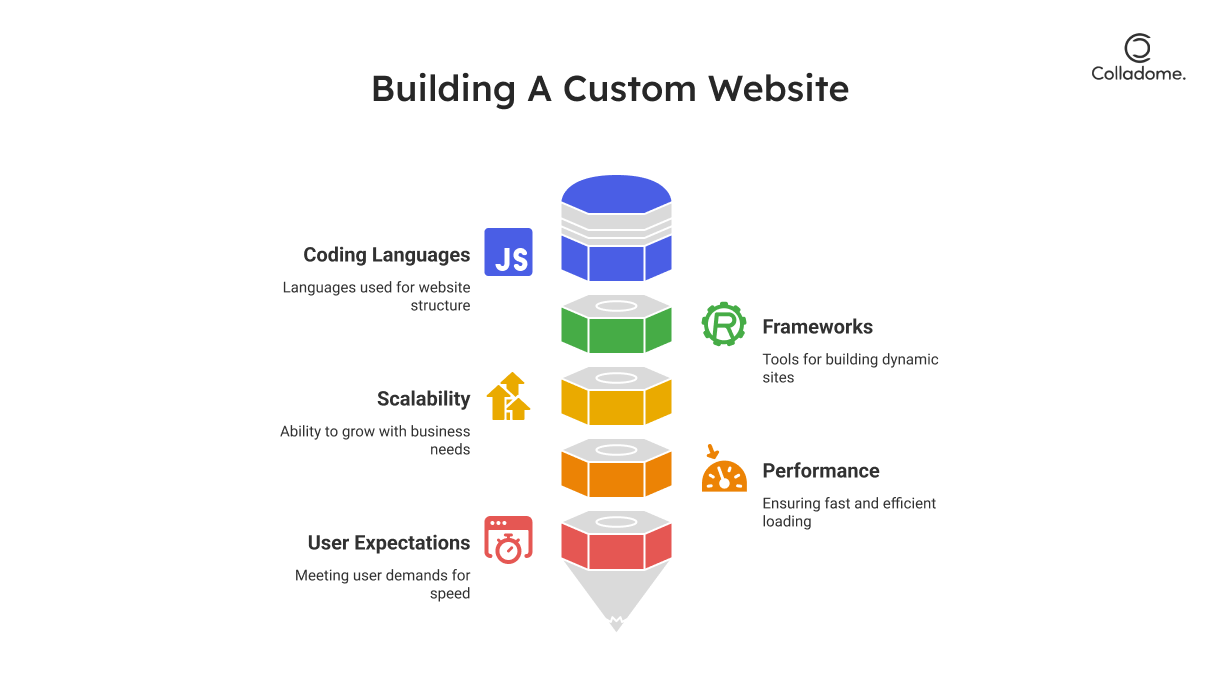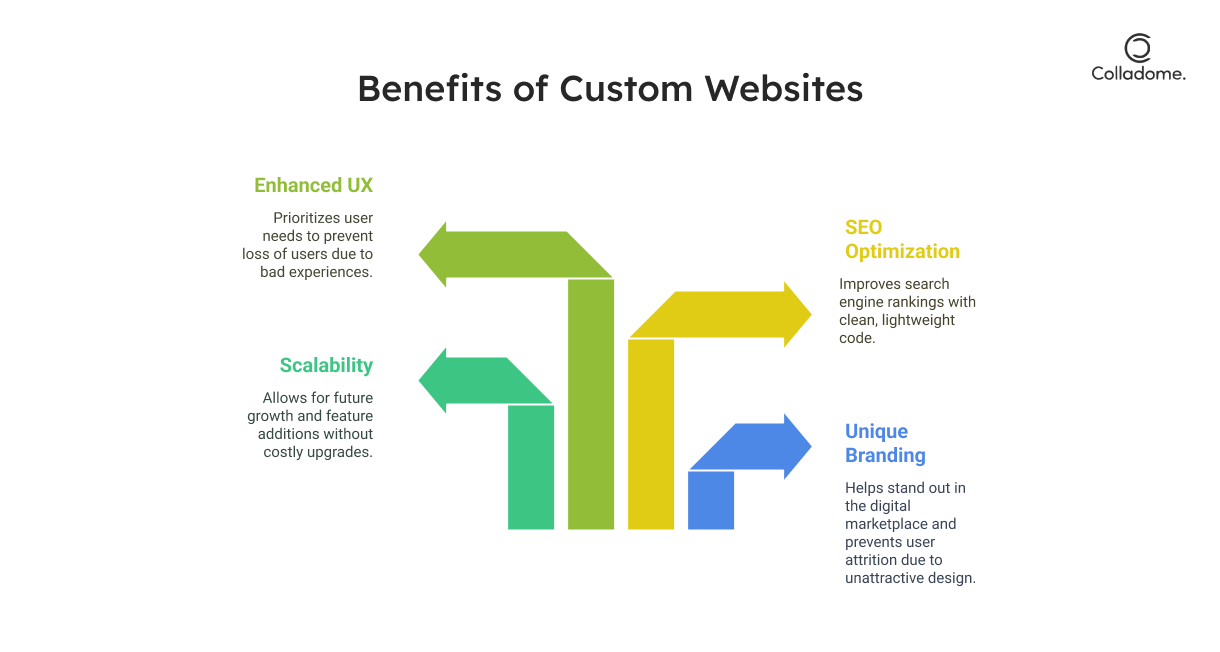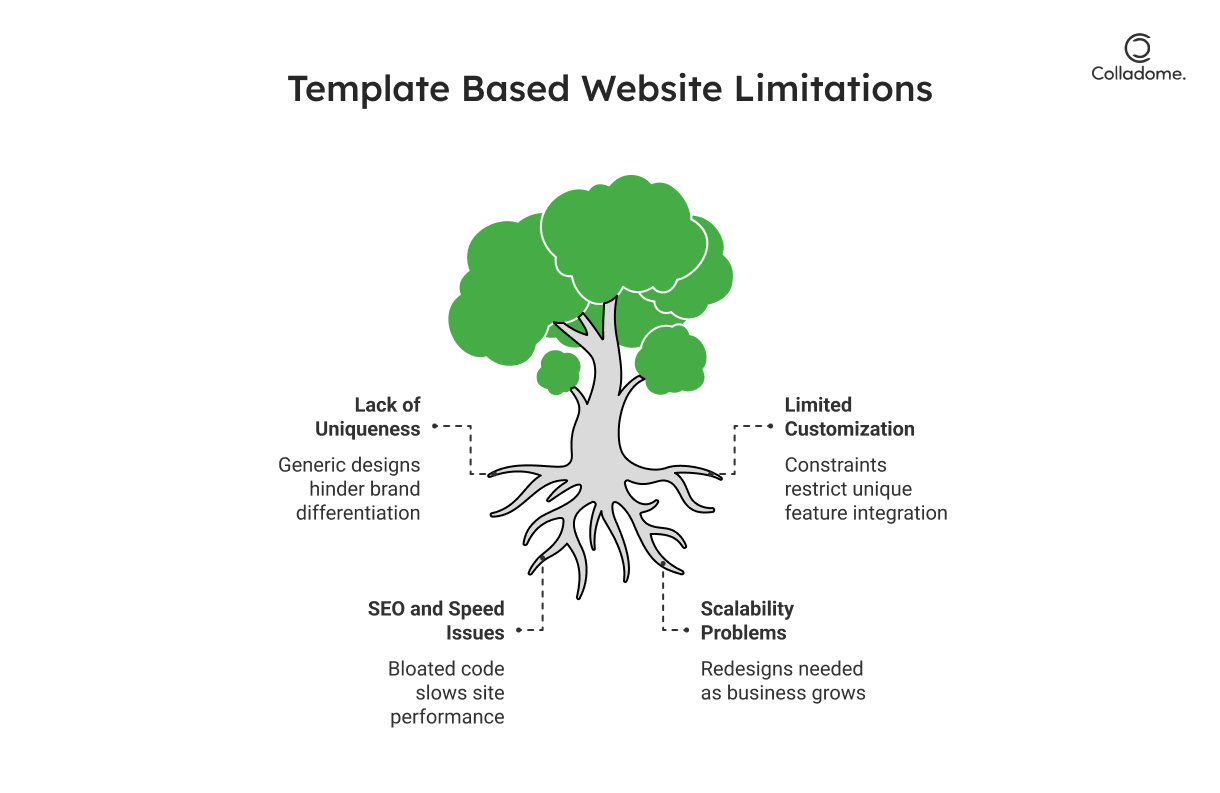In the digital world, your website is your handshake, your business card, and your first impression all rolled into one. Whether you’re running a small café, managing a growing e-commerce store, or building your personal brand, your website’s design can make or break how people perceive you. But here’s the burning question: Custom websites or templates—what’s the smarter choice?
Think of it like buying a home. Templates are like pre-fab houses. They’re affordable, ready to move into, and easy to set up. But they might not have the space for your dream kitchen or that office nook you’ve always wanted. On the flip side, custom websites are your personalized mansion. They’re built from the ground up, tailored to your exact needs, and can grow as you do—but they come with a bigger price tag and take longer to build.
For startups or budget-conscious folks, templates can be a quick fix. They’re affordable and easy to use. But they often come with restrictions—limited design freedom, slower speeds, and a generic look. Not exactly ideal if you’re trying to wow customers or beat competitors.

Custom websites, however, are the gold standard if you’re serious about your online presence. They’re built to your specifications, optimized for performance, and scalable for future growth. They scream professionalism and give your brand the unique identity it deserves.
So, which should you choose? It depends on your goals, budget, and timeline. Don’t worry—we’ll break it all down for you. By the end of this blog, you’ll know exactly which option is the best fit for you and your business! Let’s dive in.
Why the Debate Exists

When it comes to building a website, the big question—custom websites vs. templates—often comes down to three key factors: cost, flexibility, and purpose. For small businesses and startups, it’s easy to get lured in by the low-cost, plug-and-play appeal of template-based websites. But here’s the thing: with websites becoming critical for customer acquisition and retention, your design choice could have a significant impact on your bottom line.
Let’s talk numbers. Studies reveal that 88% of online consumers are unlikely to return to a website after a bad user experience. That’s almost 9 out of 10 potential customers! Poor design, slow loading speeds, or confusing navigation are all common pitfalls with templates, which often come with bloated code and limited flexibility.
On the flip side, custom website design advantages include enhanced branding and user experience. With the ability to create a site tailored to your audience, businesses that go the custom route see higher engagement rates—50% higher, on average, according to Crazy Egg. Custom sites are also built for scalability, meaning they can grow and adapt as your business evolves, unlike templates that can hit a ceiling when you need advanced features.
At first glance, templates seem like the budget-friendly choice. Platforms like Wix or Squarespace offer ready-made designs starting as low as $50. But as your needs grow, you might find yourself spending thousands on additional features or even switching to a custom site down the road. In contrast, investing in a custom website upfront ensures your online presence is unique, professional, and future-proof.
Bottom line? Templates might save you money now, but custom websites often provide a better long-term ROI by ensuring your site is fast, user-friendly, and on-brand.
What Are Custom Websites and Website Templates?
When it comes to website design, the first step is understanding the difference between custom websites and website templates. They’re like choosing between a tailored suit and off-the-rack clothing. Both can work, but it depends on your needs, style, and budget.
Custom Websites

A custom website is the bespoke solution of the digital world. It’s built from scratch to meet your exact business goals, ensuring your brand stands out. Developers use coding languages like HTML, CSS, and JavaScript, or frameworks like React and Laravel, to craft a site that’s unique to you. Want a quirky animation when users hover over a button? Done. Need a feature-rich e-commerce platform? You got it.
Custom websites are also built with scalability and performance in mind. Unlike templates, they’re free from bloated, unnecessary code, which means faster load times and better SEO performance. And in a world where 47% of users expect a site to load in under 2 seconds , speed is everything.
Website Templates

Templates, on the other hand, are pre-designed website frameworks you can get on platforms like WordPress, Wix, or Squarespace. They’re like the IKEA of websites—affordable, quick to assemble, and beginner-friendly. For as little as $50–$200, you can have a functional website up and running within hours.
But there’s a catch. Templates come with limited customization options, and because thousands of others might use the same design, your site could feel generic. They also tend to have slower speeds because of excessive preloaded features.
Over 40% of websites on the internet use WordPress templates, making it the most popular option . Yet, businesses with custom websites often report higher engagement rates and better ROI compared to those using templates.
So, which one fits your needs? Let’s dig deeper!
How to Choose: Custom Web Design or Templates?
Making the right choice between custom web design and templates can feel like deciding between building a house or renting an apartment. Both have their perks, but one might be a better fit depending on your goals. Let’s break down the advantages of custom websites and the limitations of templates, so you can make an informed decision.
1. Custom Website Design Advantages

Unique Branding
Imagine walking into a room where everyone is wearing the same outfit—it’s hard to stand out, right? That’s the problem with templates. With a custom website, your business gets a design tailored specifically to its identity, making it memorable in a crowded digital marketplace. According to Adobe, 38% of users will leave a website if the content or layout is unattractive. Custom web design ensures you don’t fall into that trap.
Scalability
As your business grows, so do your website needs. A custom site is built with scalability in mind, meaning you can easily add features like advanced e-commerce tools, member portals, or AI-driven chatbots. Templates, on the other hand, often max out their capabilities early, requiring costly upgrades or even a complete redesign down the road.
SEO Optimization
Custom websites shine when it comes to SEO. Developers can code them with clean, lightweight architecture that search engines love, helping your site rank higher. Did you know that the first result on Google gets 27.6% of all clicks?. Template-based sites often come with unnecessary code bloat, slowing down loading speeds—a big no-no for search engines and users alike.
Enhanced User Experience (UX)
A custom design is all about your audience. It’s like having a tailor adjust a suit to fit you perfectly. Developers can fine-tune every detail to meet your users’ needs, from navigation and loading speed to interactive elements. Considering that 88% of online users won’t return after a bad experience ,prioritizing UX can make all the difference.
2. Template-Based Website Limitations

Lack of Uniqueness
Let’s face it—templates can feel generic. Platforms like WordPress or Wix offer thousands of pre-designed options, but so does everyone else. There’s a high chance your site could look eerily similar to your competitors’. If your goal is to build a brand that stands out, templates might not cut it.
Limited Customization
While templates are user-friendly, they come with pre-set constraints. Want to add a unique feature or tweak the layout? You’re often limited to what the template allows. Custom websites don’t have this issue; they’re built to do exactly what you want.
SEO and Speed Issues
One of the biggest drawbacks of templates is the bloated code they often carry. They’re designed to cater to a wide audience, so they include extra features that might not even apply to your needs. This can slow down your site, hurting both user experience and SEO rankings. Remember, 53% of users abandon a website that takes more than 3 seconds to load.
Scalability Problems
Templates might work for a basic startup, but as you grow, they can become a headache. Adding features like payment gateways, customer portals, or advanced analytics might not be possible—or could break the existing design. This often forces businesses to rebuild their websites from scratch, costing more in the long run.
The Verdict?
If you’re looking for a short-term solution or have a limited budget, templates might be a good starting point. But if your business is serious about growth, branding, and providing a seamless user experience, investing in a custom website is the smarter choice. It’s an investment in your business’s future and one that often pays off with higher engagement and ROI.
Ready to take the leap? Custom or template, choose the option that aligns with your vision and goals. The digital world is waiting for you!
Cost Comparison: Custom Websites vs. Templates
Here’s a table summarizing the costs involved:
| Feature | Custom Websites | Templates |
| Initial Cost | High ($5,000 – $20,000+) | Low ($50 – $500 for templates) |
| Maintenance Cost | Moderate (Dependent on scale) | Low (Usually part of platform fee) |
| Scalability Expenses | Minimal (Built-in from the start) | High (Requires template redesign) |
| ROI | High (Enhanced branding & SEO) | Moderate (Quick but limited returns) |
Key Takeaway: While templates are more affordable upfront, the long-term ROI from a custom website often justifies its higher initial cost.
Benefits of Custom Websites Over Templates for Small Businesses
For small businesses, a strong online presence can mean the difference between thriving or being overlooked. That’s where custom websites truly shine over templates. They’re not just about looking good—they’re about delivering functionality, trust, and results tailored to your specific needs.
Localized SEO
If your small business relies on local customers, localized SEO is a game-changer. Custom websites can incorporate precise geo-targeting, making it easier for local clients to find you. For example, a bakery in Austin can optimize for search terms like “best cupcakes in Austin” through custom coding and targeted content. Templates often lack this level of detail, meaning you could miss out on key customers right in your neighborhood.
Tailored Features
Small businesses often have unique needs that go beyond what a template can offer. Think appointment booking systems, custom forms, or even interactive maps. A custom website is built to fit your specific business model, ensuring seamless functionality. Templates, while convenient, usually offer generic features that may not align with what your business truly needs.
Credibility and Trust
First impressions matter—especially online. A custom website gives you a polished, professional appearance that builds credibility and trust. It makes your small business look like a major player, even if you’re just starting out. According to Stanford Web Credibility Research, 75% of users judge a company’s credibility based on its website design. Templates, with their cookie-cutter designs, might not instill the same level of confidence.
In short, a custom website is like having a custom-tailored suit—it fits your business perfectly, helps you stand out, and leaves a lasting impression. If you’re serious about growth, custom design is worth the investment. Small businesses deserve big impact, and custom websites deliver exactly that!
Pros and Cons of Custom Website Design vs. Templates
| Aspect | Custom Websites | Templates |
| Time to Launch | Longer (4–12 weeks or more) | Faster (1–3 days) |
| Design Freedom | Full control | Limited to preset options |
| Performance | High | Variable |
| Long-term Flexibility | Excellent | Limited |
| Cost | High upfront | Affordable upfront |
Real-World Examples
Real-World Examples: Custom Websites vs. Templates
When it comes to choosing between custom websites and templates, looking at real-world examples can make the decision a lot clearer. Let’s break it down with two contrasting stories.
Example 1: Apple’s Website – The Power of Custom Design
Apple’s website is a stunning example of custom web development. The brand is known for its sleek, minimalist design, and this approach carries through to its online presence. Every detail of the site, from its intuitive navigation to the seamless integration of quick-loading pages, is carefully tailored to enhance the user experience. Apple uses custom features that fit their unique branding and customer needs—whether that’s their smooth animations, product showcases, or optimized shopping experience. This kind of personalization ensures Apple stays at the top of its game, creating a flawless, memorable experience for every user.
For small businesses, following a similar approach can be incredibly beneficial. A custom website allows you to design a site that fits your brand identity perfectly, making it more memorable and professional. It’s all about crafting an online experience that feels as polished as the business itself, just like Apple does.
Example 2: Local Coffee Shop Using a Template
Now, let’s look at a small local coffee shop that started out using a WordPress template. Initially, they created a website quickly and affordably, but as their business grew and they sought to integrate mobile ordering during the pandemic, they hit a major roadblock. The template just couldn’t scale to support the advanced features they needed, and they missed out on a lot of sales because the ordering system wasn’t as efficient as it could’ve been.
Realizing the limitations of their template, they transitioned to a custom website design, which allowed for seamless mobile integration and a much smoother ordering process. The result? A 30% boost in sales. That’s the power of having a custom design—something that grows with your business and supports new features as your needs evolve.
In both cases, the difference in website design was clear. Custom websites offered the scalability and flexibility these businesses needed to succeed, while templates served as a temporary solution that ultimately limited growth. Whether you’re a small business or a tech giant, the right website design can make all the difference.
Future Trends: Custom Web Design vs. Templates
Table: Predictions for 2025 and Beyond
| Feature | Custom Websites | Templates |
| AI Integration | Advanced, tailored AI features | Limited, generalized AI |
| Voice Search Optimization | Fully integrated | Basic support |
| Adaptation to AR/VR | Seamless | Limited |
| Mobile-First Design | Enhanced performance | Often suboptimal |
By 2025, it’s estimated that 65% of websites will prioritize custom designs to meet the growing demand for personalized digital experiences (Source: Gartner).
Conclusion
So, Which is Better: Custom Web Design or Templates?
The ultimate question—custom web design vs. templates—isn’t as simple as a yes or no answer. It all comes down to your business goals, budget, and timeline. Both options have their merits, but understanding which one aligns best with your vision will set you on the path to success.







